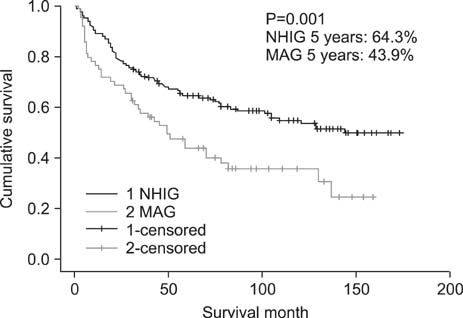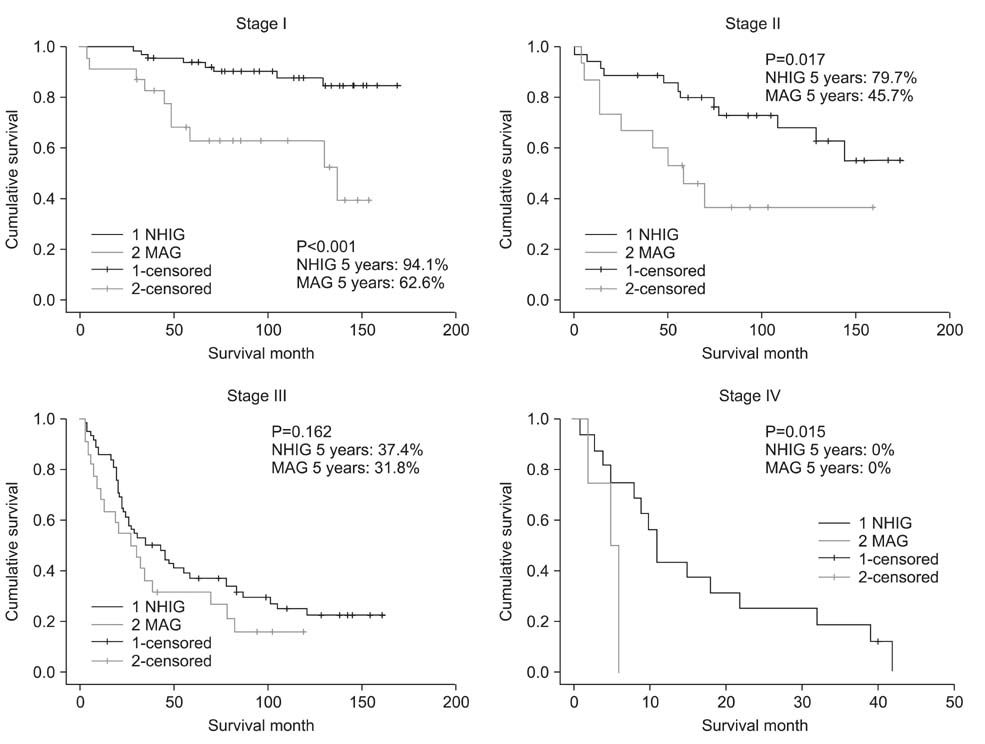J Gastric Cancer.
2013 Dec;13(4):247-254.
Differences in the Survival of Gastric Cancer Patients after Gastrectomy according to the Medical Insurance Status
- Affiliations
-
- 1Department of Surgery, Seoul Medical Center, Seoul, Korea. shindonggue@naver.com
- 2Department of Family Medicine, Seoul Medical Center, Seoul, Korea.
- 3GI Cancer Center, Dongnam Institute of Radiological & Medical Sciences, Busan, Korea.
Abstract
- PURPOSE
In Korea, the entire population must enroll in the national health insurance system, and those who are classified as having a lower socioeconomic status are supported by the medical aid system. The aim of this study was to evaluate the association of the medical insurance status of gastric cancer patients with their survival after gastrectomy.
MATERIALS AND METHODS
A total of 247 patients who underwent surgical treatment for gastric cancer between January 1999 and December 2010 at the Seoul Medical Center were evaluated. Based on their medical insurance status, the patients were classified into two groups: the national health insurance registered group (n=183), and the medical aid covered group (n=64). The survival rates were calculated using the Kaplan-Meier method.
RESULTS
The median postoperative duration of hospitalization was longer in the medical aid covered group and postoperative morbidity and mortality were higher in the medical aid group than in the national health insurance registered group (P<0.05). The overall 5-year survival rate was 43.9% in the medical aid covered group and 64.3% in the national health insurance registered group (P=0.001).
CONCLUSIONS
The medical insurance status reflects the socioeconomic status of a patient and can influence the overall survival of gastric cancer patients. A more sophisticated analysis of the difference in the survival time between gastric cancer patients based on their socioeconomic status is necessary.
Keyword
MeSH Terms
Figure
Reference
-
1. Jung KW, Won YJ, Kong HJ, Oh CM, Shin A, Lee JS. Survival of Korean adult cancer patients by stage at diagnosis, 2006-2010: national cancer registry study. Cancer Res Treat. 2013; 45:162–171.
Article2. Noh SH, Yoo CH, Kim YI, Kim CB, Min JS, Lee KS. Results after a gastrectomy of 2,603 patients with gastric cancer : analysis of survival rate and prognostic factor. J Korean Surg Soc. 1998; 55:206–213.3. Yim J, Hwang SS, Yoo KY, Kim CY. Contribution of income-related inequality and healthcare utilisation to survival in cancers of the lung, liver, stomach and colon. J Epidemiol Community Health. 2012; 66:37–40.
Article4. Kwon S. Thirty years of national health insurance in South Korea: lessons for achieving universal health care coverage. Health Policy Plan. 2009; 24:63–71.
Article5. Wedding U, Röhrig B, Klippstein A, Pientka L, Höffken K. Age, severe comorbidity and functional impairment independently contribute to poor survival in cancer patients. J Cancer Res Clin Oncol. 2007; 133:945–950.
Article6. Ahn HS, Lee HJ, Hahn S, Kim WH, Lee KU, Sano T, et al. Evaluation of the seventh American Joint Committee on Cancer/International Union Against Cancer Classification of gastric adenocarcinoma in comparison with the sixth classification. Cancer. 2010; 116:5592–5598.
Article7. Park JI, Jin SH, Bang HY, Paik NS, Moon NM, Lee JI. Survival rates after operation for gastric cancer: fifteen-year experience at a Korea Cancer Center Hospital. J Korean Gastric Cancer Assoc. 2008; 8:9–19.
Article8. Kim JG, Ryoo BY, Park YH, Kim BS, Kim TY, Im YH, et al. Prognostic factors for survival of patients with advanced gastric cancer treated with cisplatin-based chemotherapy. Cancer Chemother Pharmacol. 2008; 61:301–307.
Article9. Kadowaki S, Komori A, Narita Y, Nitta S, Yamaguchi K, Kondo C, et al. Long-term outcomes and prognostic factors of patients with advanced gastric cancer treated with S-1 plus cisplatin combination chemotherapy as a first-line treatment. Int J Clin Oncol. 2013; [Epub ahead of print].
Article10. Tocchi A, Costa G, Lepre L, Liotta G, Mazzoni G, Cianetti A, et al. The role of serum and gastric juice levels of carcinoembryonic antigen, CA19.9 and CA72.4 in patients with gastric cancer. J Cancer Res Clin Oncol. 1998; 124:450–455.
Article11. Jiexian J, Xiaoqin X, Lili D, Baoguo T, Ting S, Xianwen Z, et al. Clinical assessment and prognostic evaluation of tumor markers in patients with gastric cancer. Int J Biol Markers. 2013; 28:192–200.
Article12. Kogevinas M, Porta M. Socioeconomic differences in cancer survival: a review of the evidence. IARC Sci Publ. 1997; (138):177–206.13. Vona-Davis L, Rose DP. The influence of socioeconomic disparities on breast cancer tumor biology and prognosis: a review. J Womens Health (Larchmt). 2009; 18:883–893.
Article14. Azzopardi J, Walsh D, Chong C, Taylor C. Surgical treatment for women with breast cancer in relation to socioeconomic and insurance status. Breast J. 2013; [Epub ahead of print].
Article15. Schreiber D, Chen SC, Rineer J, Weiss J, Rotman M, Schwartz D. Racial and socioeconomic disparities in the selection of prostate brachytherapy. J Contemp Brachytherapy. 2013; 5:139–143.
Article16. Nitzkorski JR, Willis AI, Nick D, Zhu F, Farma JM, Sigurdson ER. Association of race and socioeconomic status and outcomes of patients with rectal cancer. Ann Surg Oncol. 2013; 20:1142–1147.
Article17. Siemerink EJ, Hospers GA, Mulder NH, Siesling S, van der Aa MA. Disparities in survival of stomach cancer among different socioeconomic groups in North-East Netherlands. Cancer Epidemiol. 2011; 35:413–416.
Article18. Lowrie EG, Lew NL. Death risk in hemodialysis patients: the predictive value of commonly measured variables and an evaluation of death rate differences between facilities. Am J Kidney Dis. 1990; 15:458–482.
Article19. Seo KW, Yoon KY. Nutritional assessment and perioperative nutritional support in gastric cancer patients. Korean J Gastroenterol. 2013; 61:186–190.
Article20. Shim H, Cheong JH, Lee KY, Lee H, Lee JG, Noh SH. Perioperative nutritional status changes in gastrointestinal cancer patients. Yonsei Med J. 2013; 54:1370–1376.
Article21. Nitenberg G, Raynard B. Nutritional support of the cancer patient: issues and dilemmas. Crit Rev Oncol Hematol. 2000; 34:137–168.
Article22. Ottery FD. Definition of standardized nutritional assessment and interventional pathways in oncology. Nutrition. 1996; 12:S15–S19.
Article23. Baker A, Wooten LA, Malloy M. Nutritional considerations after gastrectomy and esophagectomy for malignancy. Curr Treat Options Oncol. 2011; 12:85–95.
Article24. Kwon YM, Lim HT, Lee K, Cho BL, Park MS, Son KY, et al. Factors associated with use of gastric cancer screening services in Korea. World J Gastroenterol. 2009; 15:3653–3659.
Article25. Lee K, Lim HT, Hwang SS, Chae DW, Park SM. Socio-economic disparities in behavioural risk factors for cancer and use of cancer screening services in Korean adults aged 30 years and older: the Third Korean National Health and Nutrition Examination Survey, 2005 (KNHANES III). Public Health. 2010; 124:698–704.
Article26. Seo JH, Kim N, Lee DH, Kim JW, Hwang JH, Park YS, et al. Clinical features and recent treatment trend of gastric cancer. Korean J Med. 2006; 71:149–157.
- Full Text Links
- Actions
-
Cited
- CITED
-
- Close
- Share
- Similar articles
-
- Different Clinical Outcomes of Stage IV Gastric Cancer according to the Curability of Surgery
- Laparoscopic Surgery for Advanced Gastric Cancer: Current Status and Future Perspectives
- Significance of a Splenectomy with a Curative Total Gastrectomy for Gastric Cancer A trospective analysis of 237 cases
- Nutritional Consequences and Management After Gastrectomy
- Treatment Modality Based Survival in Gastric Carcinoma Patients with Stand-Alone Peritoneal Metastasis: a Case-Control Study



